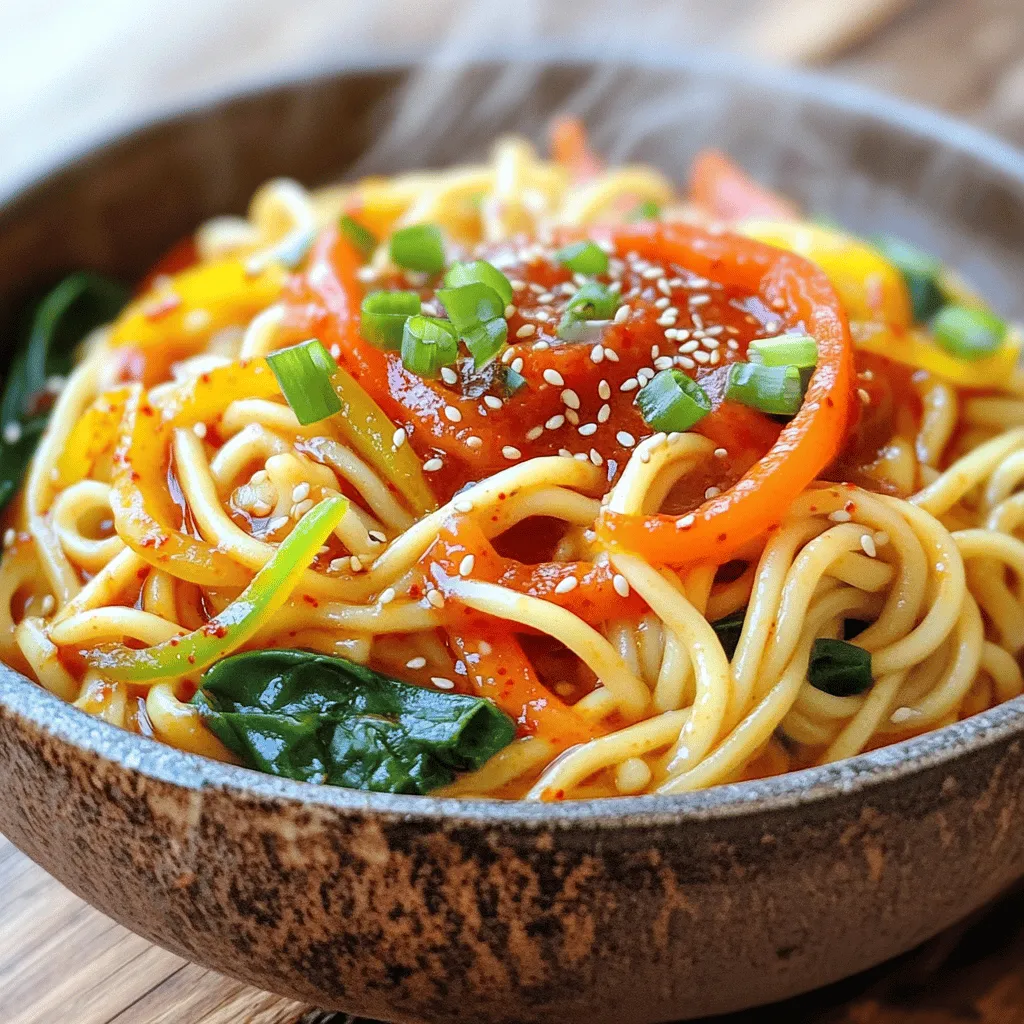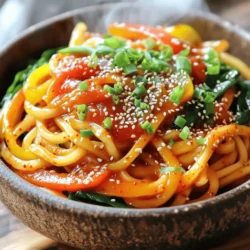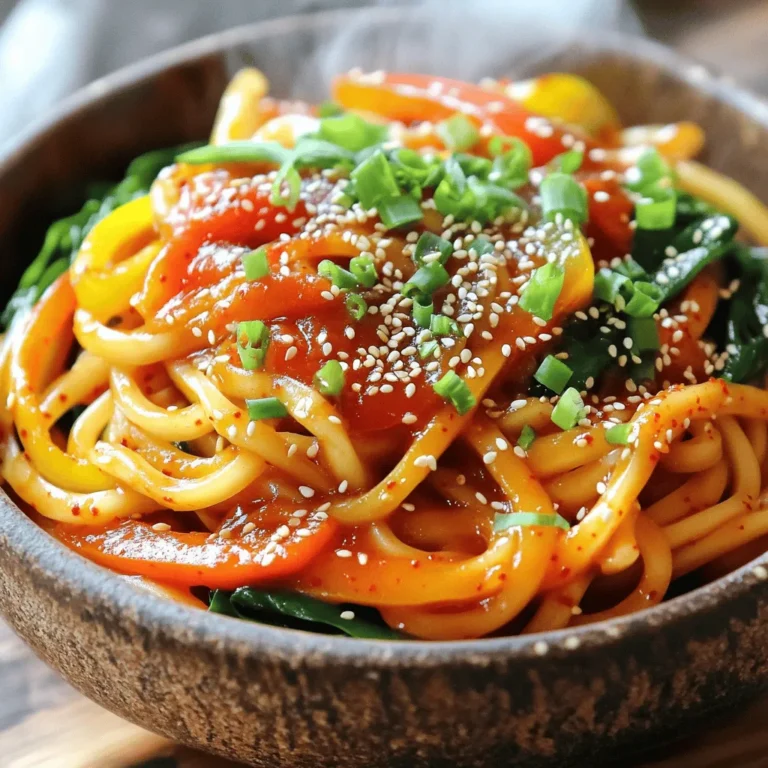Craving a quick, spicy meal? Let’s dive into making Korean Gochujang Noodles! This dish is simple and bursting with flavor. With just a few key ingredients, you can whip up a satisfying meal in no time. In this guide, I’ll walk you through the steps, tips, and even variations to make it your own. Get ready to enjoy a delightful taste of Korea right at home!
Ingredients
To make Korean Gochujang Noodles, you need to gather the right ingredients. Here’s what you will need:
– 200g noodles (preferably udon or soba)
– 2 tablespoons gochujang (Korean chili paste)
– 1 tablespoon soy sauce
– 1 tablespoon sesame oil
– 1 tablespoon honey or maple syrup
– 2 cloves garlic, minced
– 1 teaspoon ginger, grated
– 1 bell pepper, thinly sliced (red or yellow)
– 1 cup spinach leaves
– 1 green onion, chopped
– Sesame seeds for garnish
– Optional protein: 100g tofu, chicken, or shrimp
These ingredients create a perfect blend of flavors. The gochujang brings heat, while the honey adds sweetness. You can customize it with your choice of protein for extra nutrition. Remember, this recipe is about balance. Each ingredient plays a role in the final taste.It will guide you through the cooking steps for this delicious dish.
Step-by-Step Instructions
Cooking the Noodles
To start, bring a large pot of salted water to a boil. Add 200g of your favorite noodles, like udon or soba. Cook them until they are al dente, which usually takes around 5 to 7 minutes. Once cooked, drain the noodles and rinse them under cold water. This step stops the cooking process and keeps them firm. Set the noodles aside for later.
Preparing the Sauce
Next, grab a small bowl. In this bowl, mix together 2 tablespoons of gochujang, 1 tablespoon of soy sauce, 1 tablespoon of sesame oil, and 1 tablespoon of honey or maple syrup. Add 2 cloves of minced garlic and 1 teaspoon of grated ginger. Whisk everything together until it’s well combined. The sauce should be thick and spicy but sweet. This is the heart of your dish.
Sautéing the Vegetables
Now, take a large skillet or wok and heat a splash of oil over medium heat. Add 1 thinly sliced bell pepper. Stir-fry it for about 2 to 3 minutes. You want the pepper to soften a bit. Then, toss in 1 cup of spinach leaves and cook until they wilt, which should take about 1 minute. This step adds color and nutrition to your noodles.
Cooking Optional Proteins
If you want to add protein, now is the time. You can use 100g of tofu, chicken, or shrimp. Add your chosen protein to the skillet with the veggies. Sauté until the protein is cooked through. If using chicken or shrimp, this will take about 5 to 7 minutes. For tofu, cook until it’s golden. This makes the meal more filling.
Combining Noodles and Sauce
Once your protein is cooked, add the reserved noodles to the skillet. Pour the prepared gochujang sauce over the noodles. Toss everything together until the noodles are coated well with the sauce. Heat the mixture through for a couple of minutes. This step makes sure every noodle is full of flavor.
Final Touches and Serving
After combining, remove the skillet from heat. Fold in 1 chopped green onion for freshness. Taste your dish and adjust the seasoning if needed. If you want more spice, add more gochujang or soy sauce. To serve, divide the noodles into bowls. Sprinkle sesame seeds on top for a nice touch. Enjoy your Korean Gochujang Noodles!
Tips & Tricks
Best Noodles to Use
I love using udon or soba noodles for this dish. Udon is thick and chewy, while soba is thin and nutty. Both hold the sauce well. You can also try rice noodles for a gluten-free option. Just follow the package instructions to cook them perfectly.
Adjusting Spice Level
Gochujang brings heat, but you can control it. Start with two tablespoons if you love spice. For less heat, use one tablespoon instead. Taste the sauce before mixing it with noodles. You can always add more gochujang later.
Making it Vegetarian or Vegan
This dish is easy to make vegetarian or vegan. Simply skip the meat and use tofu for protein. You can also add more veggies like mushrooms or carrots. Always check the honey you choose. Use maple syrup for a vegan option.

Variations
Gluten-Free Option
You can make Korean Gochujang Noodles gluten-free. Use rice noodles instead of udon or soba. Look for gochujang that has no wheat. This way, you can enjoy the dish without worrying about gluten.
Adding Extra Vegetables
To boost nutrition, add more veggies to your noodles. Consider using carrots, zucchini, or broccoli. These add color and crunch. Sauté them with the bell pepper. This simple step brings more flavor and makes your meal heartier.
Mixing in Different Proteins
You can switch up the protein based on your taste. Chicken, shrimp, or tofu work great. If you want a vegetarian option, stick with tofu. For a quick meal, use pre-cooked proteins. They save time and keep the dish easy.
Storage Info
Storing Leftovers
To store your Korean Gochujang Noodles, let them cool first. Then, place the noodles in an airtight container. They can last in the fridge for up to three days. Make sure to separate any protein if you added it, as it may change texture.
Reheating Instructions
When you’re ready to eat, you can easily reheat your noodles. Use a microwave-safe dish and add a splash of water. Cover it with a lid or microwave-safe wrap. Heat in short bursts, about 30 seconds at a time, stirring in between. Check until they are hot throughout.
Freezing Gochujang Noodles
You can freeze these noodles for later. First, cool them completely. Portion them into freezer-safe bags or containers. Squeeze out as much air as you can. They will keep well for up to three months. To eat, thaw them in the fridge overnight before reheating. For the best flavor, try to eat them fresh.
FAQs
What is gochujang?
Gochujang is a red chili paste from Korea. It has a sweet, spicy, and savory flavor. The main ingredients are chili powder, glutinous rice, fermented soybeans, and salt. You can use it in many dishes, like marinades and stews. It adds a unique depth to your meals.
Can I substitute gochujang with another ingredient?
Yes, you can! If you need a substitute, try mixing red pepper flakes with a bit of honey and soy sauce. This mix gives a similar sweet and spicy taste. However, it may not match gochujang’s rich flavor completely.
How to make Korean Gochujang Noodles spicy?
To amp up the heat in Korean Gochujang Noodles, add more gochujang to the sauce. You can also mix in some crushed red pepper flakes or sliced fresh chili peppers. Start small, then taste as you go. Adjust to your spice preference.
What are the best side dishes to serve with Korean Gochujang Noodles?
Great side dishes include:
– Kimchi
– Korean pickled radish
– Steamed dumplings
– A light salad with sesame dressing
These options balance the noodles’ heat and add texture to your meal.
How do I find authentic Korean Gochujang?
To find authentic gochujang, visit an Asian grocery store. Many carry brands from Korea. Check the label for quality ingredients and no artificial additives. You can also shop online for trusted brands.It includes details on ingredients, cooking time, and step-by-step instructions. Enjoy making this dish in your own kitchen!
In this post, we explored how to make delicious Korean Gochujang noodles. We outlined the key ingredients, detailed cooking steps, and shared helpful tips. You can customize your dish and try various protein options or vegetables. Remember, adjusting the spice level keeps it fun for everyone. With simple storage and reheating tips, you can enjoy these noodles anytime. Making this meal will impress your family and friends, so give it a try!


